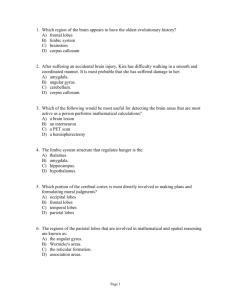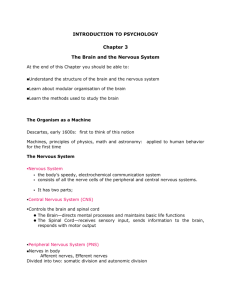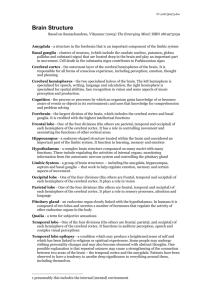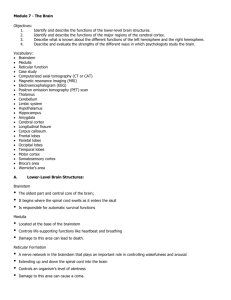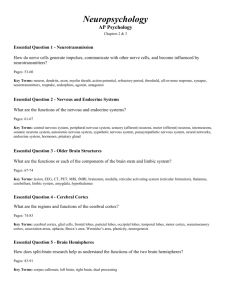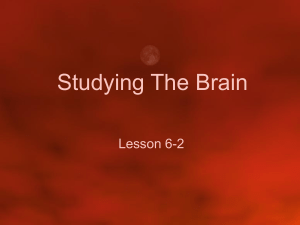Unit 3 Psychology sample notes - 2010
advertisement
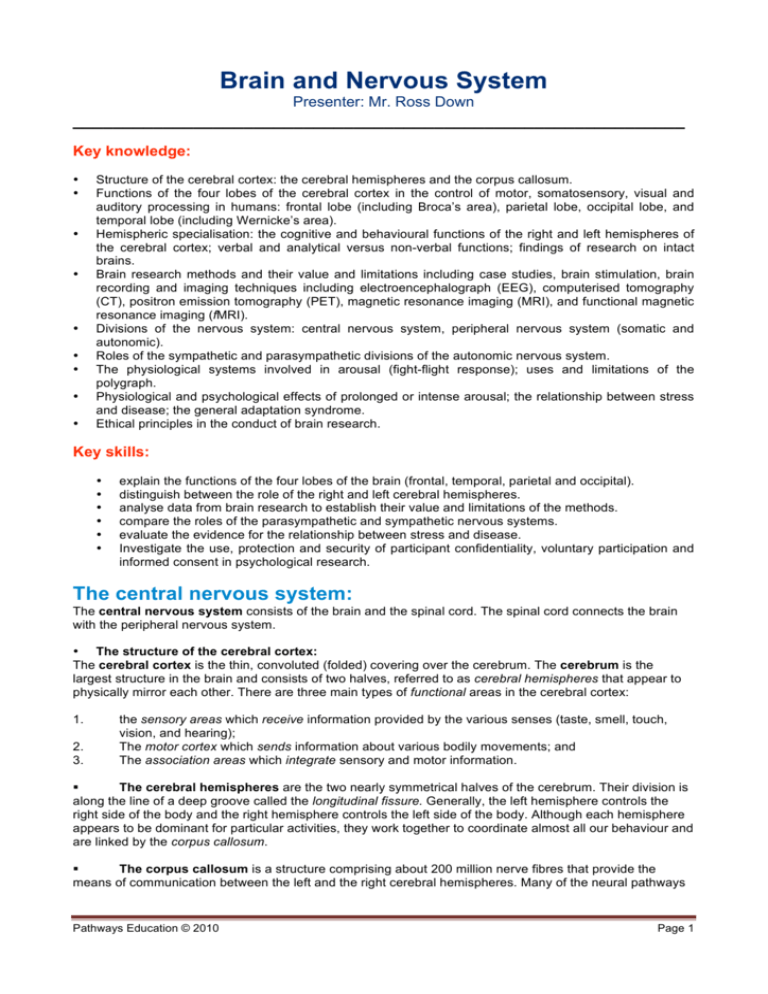
Brain and Nervous System Presenter: Mr. Ross Down _____________________________________________________________ Key knowledge: • • • • • • • • • Structure of the cerebral cortex: the cerebral hemispheres and the corpus callosum. Functions of the four lobes of the cerebral cortex in the control of motor, somatosensory, visual and auditory processing in humans: frontal lobe (including Broca’s area), parietal lobe, occipital lobe, and temporal lobe (including Wernicke’s area). Hemispheric specialisation: the cognitive and behavioural functions of the right and left hemispheres of the cerebral cortex; verbal and analytical versus non-verbal functions; findings of research on intact brains. Brain research methods and their value and limitations including case studies, brain stimulation, brain recording and imaging techniques including electroencephalograph (EEG), computerised tomography (CT), positron emission tomography (PET), magnetic resonance imaging (MRI), and functional magnetic resonance imaging (fMRI). Divisions of the nervous system: central nervous system, peripheral nervous system (somatic and autonomic). Roles of the sympathetic and parasympathetic divisions of the autonomic nervous system. The physiological systems involved in arousal (fight-flight response); uses and limitations of the polygraph. Physiological and psychological effects of prolonged or intense arousal; the relationship between stress and disease; the general adaptation syndrome. Ethical principles in the conduct of brain research. Key skills: • • • • • • explain the functions of the four lobes of the brain (frontal, temporal, parietal and occipital). distinguish between the role of the right and left cerebral hemispheres. analyse data from brain research to establish their value and limitations of the methods. compare the roles of the parasympathetic and sympathetic nervous systems. evaluate the evidence for the relationship between stress and disease. Investigate the use, protection and security of participant confidentiality, voluntary participation and informed consent in psychological research. The central nervous system: The central nervous system consists of the brain and the spinal cord. The spinal cord connects the brain with the peripheral nervous system. • The structure of the cerebral cortex: The cerebral cortex is the thin, convoluted (folded) covering over the cerebrum. The cerebrum is the largest structure in the brain and consists of two halves, referred to as cerebral hemispheres that appear to physically mirror each other. There are three main types of functional areas in the cerebral cortex: 1. 2. 3. the sensory areas which receive information provided by the various senses (taste, smell, touch, vision, and hearing); The motor cortex which sends information about various bodily movements; and The association areas which integrate sensory and motor information. The cerebral hemispheres are the two nearly symmetrical halves of the cerebrum. Their division is along the line of a deep groove called the longitudinal fissure. Generally, the left hemisphere controls the right side of the body and the right hemisphere controls the left side of the body. Although each hemisphere appears to be dominant for particular activities, they work together to coordinate almost all our behaviour and are linked by the corpus callosum. The corpus callosum is a structure comprising about 200 million nerve fibres that provide the means of communication between the left and the right cerebral hemispheres. Many of the neural pathways Pathways Education © 2010 Page 1 from the sensory and motor cortices in the brain and the parts of the body to which they connect, cross from one side of the body to the other via the corpus callosum. • The four lobes of the cerebral cortex: The four cortical lobes of the cerebral cortex are anatomical regions. They are not areas of specific function necessarily, although they provide the anatomy in which specific functional areas are located. The lobes are divided across the cerebral hemispheres, so that there is a left and right component to each of the four lobes. 1. The frontal lobes are the largest of the four lobes and occupy the upper forward half of the cerebral hemispheres. The primary motor cortex is located across the very rear of the frontal lobes. Specific points along the motor cortex are responsible for generating movement of particular body parts. In the forward section of the frontal lobe is an association area. This is involved with tasks such as planning, judging, and using initiative. Association areas in the frontal lobes are also involved with the expression of emotional behaviour and with certain personality characteristics; especially those that relate to temperament. ♦ Broca’s Area Broca’s area is located in the left frontal lobe and is involved with the production of clear, fluent speech. It is sometimes referred to as the ‘speech production centre,’ although this can be a little misleading. – Speech, like any other voluntary movement is initiated by the motor cortex. The role Broca’s area plays is more concerned with the determination of the language messages that will be carried out by the motor cortex. For example, there will be different movements required by the mouth, jaws, tongue, throat, and so on, for every different sounding word. By determining which words will be used, Broca’s area indirectly determines the messages sent out by the motor cortex to produce the necessary sounds for saying them. Broca’s area is also concerned with the meaning of words, the structure of sentences, and with parts of speech such as adjectives, prepositions and conjunctions. Broca’s area is involved with analysing the grammatical structure of sentences that we hear as well as those that we speak. This is evident from research with patients who have suffered damage to Broca’s area. Their speech typically comprises short sentences of just three or four words that consist mainly of nouns and verbs; for example, “Got ticket, went concert.” And when listening to speech, people suffering from damage to Broca’s area become confused when the usual sequence of words in a sentence is changed. For example, “The boy was attacked by the dog” (rather than the more orthodox “The dog attacked the boy’) would not indicate to such a person which animal was attacked. 2. The parietal lobes are responsible for integrating visual information and monitoring the body’s position in space. They are located behind the central fissure and forward of the occipital lobes. The parietal lobes include the area known as the somatosensory cortex which runs along the central fissure, immediately opposite the primary motor cortex. The somatosensory cortex registers the sense of touch, by receiving information from sensory receptors around the body about pressure, pain, temperature, muscle movement and position. It is also involved in identifying where things are located in our visual field. 3. The occipital lobes are the regions in which visual information is received and processed. They are located at the rear of each cerebral hemisphere. Visual information from the eyes first arrives at the primary visual cortices, located at the base of the occipital lobes. The remainder of the occipital lobes consists of visual association areas which bring together both visual information and information from other areas of the cerebral cortex. This enables us to form visual images of memories and to think visually. The visual association areas extend beyond the occipital lobes into the temporal and parietal lobes. 4. The temporal lobes are the location of the primary auditory cortices which are responsible for receiving and processing sound. They are located beneath the temple bones of the skull, around the top and forward of the ears. The temporal lobes also play an important part in memory; particularly the ability to remember faces, and the identification of most objects. i.e. when we look at something, certain areas of the temporal lobes are involved in interpreting what it is. ♦ Wernicke’s area is located in the left temporal lobe, behind Broca’s area, next to the primary auditory cortex. Wernicke’s area is involved with interpreting sound and plays a vital role in understanding human speech. It is sometimes referred to as the “language comprehension centre.” Wernicke’s area seems to be responsible for locating and retrieving words from memory to express intended meanings when we speak or write. Although people with damage to Wernicke’s area are still able to speak fluently and string long sentences together; what they actually say is largely meaningless. This occurs because of their inability to select the right words to say what they mean. Pathways Education © 2010 Page 2 ♦ REMEMBER: FPOT (Frontal, Parietal, Occipital, Temporal) to remember the names of the four lobes. REMEMBER: Broca’s area is located in the left frontal lobe and is involved with speech production, whereas Wernicke’s area is located in the left temporal lobe and is involved with comprehending language. Associate the mouth both with speech production and with being at the front (frontal lobe). Associate an ear both with comprehending language and with being next to the auditory cortex in the temporal lobe. Hemispheric specialisation: Hemispheric specialisation refers to the specialisation and dominance of certain brain functions by each of the cerebral hemispheres. Although the two hemispheres look the same and generally function together in a coordinated, interactive fashion, there are some specialised functions that predominate in just one hemisphere. Left hemisphere functions: Verbal functions such as reading, writing, speaking and understanding speech appear to be predominantly functions of the left hemisphere. Analytical functions such as mathematical logic, analysing, organising and interpreting scientific data are also functions that are dominated by the left hemisphere. Right hemisphere functions: Non-verbal functions do not require the use or recognition of words and these are thought to be dominated by the right hemisphere. Examples include recognising a face or a tune, doing spatial tasks such as jigsaw puzzles, and producing or appreciating works of art. Daydreaming is also thought to occur predominantly in the right hemisphere. Pathways Education © 2010 Page 3 • Research on hemispheric specialisation with intact brains: Studies of people with intact brains could not be conducted ethically until quite recently. The technology to determine what was occurring in various cortical areas without opening the skull was not available. In the 1950’s, Juhn Wada developed a technique for determining which hemisphere controls the ability to speak. This technique was developed to avoid damage to speech in patients requiring brain surgery. Known as the Wada test, it involves injecting a sedative drug into an artery in the neck which supplies blood to that side (hemisphere) of the brain. The patient is asked to raise both arms in the air and count from 1 to 20. Very soon after the injection, the arm on the opposite side of the body to that of the injection falls limp. When that arm is pinched, the patient shows no response. The patient therefore demonstrates hemispheric specialisation for processing sensations and control of voluntary movement. If they cease counting when the drug is injected into the left side of the neck, this is taken as evidence for left hemispheric specialisation of language. Despite its initial purpose as a ‘safety mechanism’ for patients requiring brain surgery, the Wada test has been used as a research tool quite extensively. By anaesthetising the right hemisphere, people mistake famous faces for their own. This suggests that facial recognition is a right hemisphere function. The use of a tachistoscope to project images to the left or right hemispheres is another technique that demonstrates hemispheric specialisation. When verbal tasks are projected to the left hemisphere, they are generally processed (identified) faster than when they are projected to the right hemisphere. The reverse also holds true for non-verbal images projected to the right hemisphere. The very small difference of about 20 milliseconds suggests the hemispheric specialisation of these tasks. It is important to note that researchers do not assign tasks exclusively to one hemisphere or the other. Research studies indicate that the brain can be quite flexible – this is referred to as the plasticity of the brain – and functions traditionally associated with one hemisphere can be relocated in the opposite hemisphere if Pathways Education © 2010 Page 4 there is damage to the area that normally controls a given function. Research also shows that the brain’s flexibility is greater when the individual is young. • Brain research methods: Early brain research methods were largely confined to learning about the structure of the brain, rather than the function of particular areas. Furthermore, they relied heavily on the goodwill of people to either donate their bodies to medical science, or to allow researchers to conduct case studies after they had been involved in accidents that damaged the brain or had undergone brain surgery. In later years, electrical stimulation th allowed researchers to learn more about structures and their functions and by the mid-20 century, the th electroencephalograph (EEG) was available. The latter half of the 20 century saw the introduction and development of brain imaging techniques which were non-intrusive and which provided a much clearer picture of the functions of different brain regions. (i) Case Study – This is an in-depth study of a particular behaviour of interest in an individual or group. It might entail direct observation, diagnostic tests, interviews and analyses of medical records. In brain research it is used most often to study rare and unusual disorders or conditions in individual patients rather than in groups. An example of one of the earliest brain research case studies is that of Phineas Gage, a railway construction worker who had an iron rod blown through his frontal lobes. The report compiled by his doctor (John Harlow) at the time of the accident (in 1848) indicated a radical change in his temperament and his social behaviour. This case study detailed one of the first insights into the role of the frontal lobes in determining behaviour. Nearly 150 years later, researchers conducted case studies of patients with damage to the same areas of the brain as Gage and discovered that the behavioural consequences for them mirrored those of Gage. The main value of case studies is that they provide a comprehensive overview of the patient’s life, a full description of their problem, their behaviour and their mental capabilities. One limitation is that the process of analysing, summarising and reporting the data is an expensive and time-consuming one. Another limitation of case studies in brain research is due to the fact that they focus on the rare and unusual conditions and can therefore rarely be generalised to other patients or problems. Furthermore, it is rare to find identical brain damage in two or more individuals and even if they are very similar, the respective mental capacities of the patients before and after the brain damage is probably different anyway. Finally, because the brain has the ability to compensate for damage by other areas taking on functions previously undertaken by the damaged areas, understanding the true effect of the brain damage using case studies can be difficult. (ii) Electrical stimulation of the brain (ESB) – This involves use of an electrode to administer a precisely measured and targeted electrical current to a specific area of the brain. Weak electrical signals are generated by the neurons throughout the nervous system. This electrical activity can be either stimulated or monitored by electrodes. If electrical stimulation of a specific brain area causes a particular behavioural response, then it is assumed that this area of the brain is responsible for (or at least involved with) that particular behaviour. ESB may have the opposite effect too - it may inhibit a response rather than initiate one. This will only be evident if the patient is already actively engaged in a behaviour (such as talking) and the electrical stimulation of the brain area causes it to stop. ESB has been a valuable tool in brain research. It has enabled researchers to identify the functions of many brain areas. It has also played a significant role in identifying certain functions that appear to be performed predominantly by one hemisphere or the other (i.e. hemispheric specialisation). A major limitation of ESB is that it can only be used with people who are undergoing brain surgery. It is also an extremely invasive procedure that would not be considered ethical in any other circumstance other than during surgery that was already necessary. As with case studies, it is difficult to generalise from the results of studies using ESB. For one thing, most ESB studies have been conducted on patients suffering from epilepsy – one could not generalise their results to the brains of nonepileptics. Pathways Education © 2010 Page 5 (iii) Electroencephalograph (EEG) – The EEG detects, amplifies and records brain wave activity using small electrodes attached to the surface of the scalp. The records made are called electroencephalograms. Brain wave patterns are categorised by letters of the Greek alphabet: alpha, beta, delta and theta. The patterns vary in brain wave amplitude (height of the waves) and frequency (rate of the waves). The EEG has been used widely in diagnosing and studying various brain-related medical conditions (eg. epilepsy, Parkinson’s disease). They have also been used in the identification of some mental illnesses (eg. depression and schizophrenia) and in the diagnosis of apraxia (the inability to initiate or organise voluntary movements, despite there being no muscular reason for it). The main value of the EEG is in providing general information about brain activity without being invasive. The equipment is more readily accessible than the expensive neuro-imaging devices. The EEG can study brain waves over an extended time period as demonstrated in sleep studies where brain waves are monitored for hours on end. EEG studies have provided useful information about brain wave activity associated with various thoughts, feelings and behaviours, and about hemispherically specialised functions. A limitation of the EEG is that it does not provide detailed information about the particular brain structures that are activated and what their specific functions are. This is because the electrodes detect electrical activity from a broad area of the brain. (iv) Computerised tomography (CT) or computerised axial tomography(CAT) (CAT) is a neuroimaging tool that produces a computer enhanced slice of the brain from X-rays that are taken from different angles. The X-ray machine moves in an arc around the head while the computer collates different ‘snap shots’ of the brain to produce a composite image. The X-rays consist of very low levels of radiation and is considered harmless. A substance referred to as ‘contrast’ is injected into a vein in the arm or hand to highlight the brain’s blood vessels. This substance has no ill effects. This procedure is not considered to be invasive by psychologists and medical experts. The CT scan is capable of revealing the effects of strokes, tumours, and brain injuries. It can also detect physical abnormalities in the brain structures of people with psychological disorders such as depression and schizophrenia. Physical changes in certain brain structures of people with Parkinson’s disease and Alzheimer’s disease can also be detected by a CT scan. The main limitation of the CT scan is that it only shows brain structure. It provides no information about the function of the brain or the activity of the part being scanned. (iv) Magnetic resonance imaging (MRI) – is a technique that uses harmless magnetic fields and radio waves to cause atoms in the neurons of the brain to vibrate. The vibrations are detected by a large magnet in the chamber that encloses the person undergoing the procedure. The magnet channels the vibrations into a computer that is programmed to organise them into a colour-coded image that indicates areas of high and low brain activity. MRI produces an image that is clearer and more detailed than a CT scan. In fact, an MRI image can distinguish cells that are cancerous from those that are not. MRI is used for a range of purposes: diagnosing structural abnormalities of the brain, detection of spinal cord abnormalities, detection of degenerative diseases of the central nervous system, prosopagnosia (an inability to recognise familiar faces despite having the ability to recognise familiar objects), and akinetopsia (the lack of motion perception). Pathways Education © 2010 Page 6

